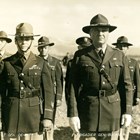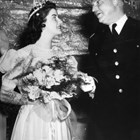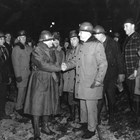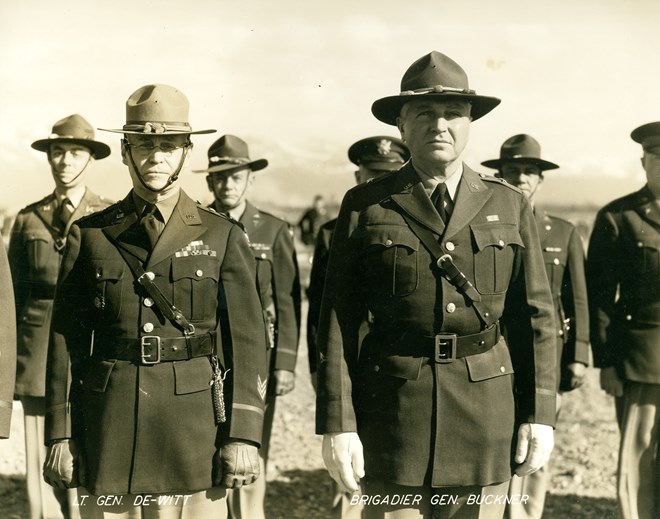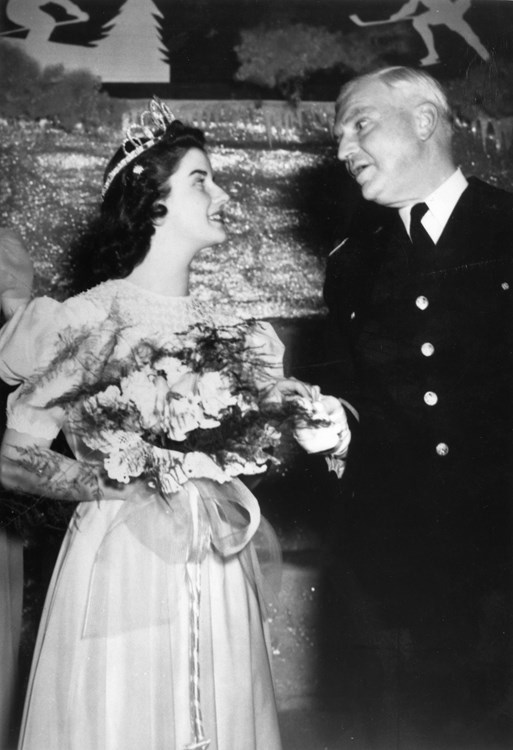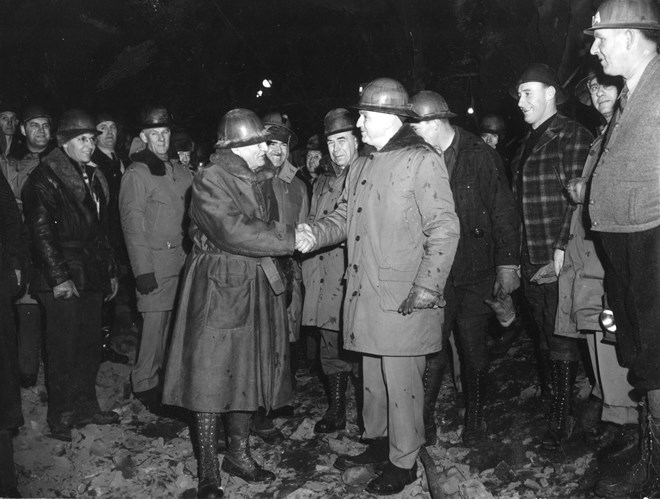Buckner, Simon Bolivar, Jr.
1886-1945 | Brigadier General, U.S. Army
General Simon Bolivar Buckner Jr. is credited with fortifying and protecting Alaska during World War II and repelling the Japanese from the Aleutian Islands. Arriving in Anchorage in 1940, he used his drive and dedication to begin intense construction in preparing Alaska’s defenses and later received the Distinguished Service Cross in recognition of making the Alaska Defense Command a credible military force and in reward for his Attu actions. One of Buckner’s projects was the construction of the military Port of Whittier and a railroad spur tunnel, now named for Anton Anderson, the chief engineer on the project. He became known as “The Silver Stallion of Alaska.” He left in June 1944, after significant numbers of troops were withdrawn from Alaska, to command the Tenth Army in the invasion of Okinawa, the last great battle of the Pacific campaign. On June 22, 1945, he was struck by shrapnel from a Japanese shell, only three days before the surrender of the Japanese garrison. He was the highest ranking U.S. military officer killed during World War II. Buckner had intended to retire and live in Anchorage after the war, where he had purchased a homesite on a bluff overlooking Knik Arm, and a farm in Homer.
Early Years
Simon Bolivar Buckner Jr. was born on July 18, 1886 at Glen Lily, the thousand-acre family estate near Munfordville, Hart County, Kentucky, on July 18, 1886. His father, Simon Bolivar Buckner Sr., was a Confederate lieutenant general and, following the Civil War, entered politics, becoming the adjutant general of Illinois and later governor of Kentucky (1887-1891).1 As a sixty-two year old widower, the senior Buckner married twenty-eight year old Delia Hayes Claiborne Buckner in 1885 and, the following year, she gave birth to Simon Bolivar Buckner, Jr. As a young boy, he was adored by his aging father and young mother, and grew up in the rugged, rolling, wooded hills of Kentucky, where he developed a life-long passion for the outdoors.2
Military Career
Buckner’s military education began at the Virginia Military Institute, 1902-1904. He graduated from the U.S. Military Academy at West Point in 1909, ranking 57th in his class of 107. From 1908 to 1917, he was assigned to Army infantry units in Texas, the Philippines, Kentucky, Texas again, Washington, DC, and a second tour of duty in the Philippines.3
Buckner was promoted to captain in 1917 in his ninth year of service. He was soon promoted again in 1920, when he received a promotion to major from the U.S. Army. He was promoted to lieutenant colonel in 1932 and to colonel in 1937.
During World War I and until 1936, almost all of Buckner’s military assignments were in training at military schools, either as a student, instructor, or as a commander in training units. He developed a reputation as a strict, but fair, officer. After his promotion to captain, he was transferred to the Aviation Section, U.S. Army Signal Corps, and took flight training at Kelly Field, Texas (1917-1918). His assignments included training as a student at the Infantry School at Fort Benning, Georgia (1924); four years at the Command and General Staff School, Fort Levenworth, Kansas (distinguished graduate, 1925), with three years as an instructor (1925-1928); four years at the Army War College, Washington, DC, (student, 1929), and three years as an instructor (1929-1932). He was the Commandant of Cadets at the U.S. Military Academy at West Point (1933-1936), and served as a faculty member (Instructor, 1919-1923 and 1932-1933). In 1936, he served as Executive Officer of the 23rd Infantry Regiment at Fort Sam Houston, Texas. Briefly, he led the 66th Infantry (Light Tank) at Fort Meade, Maryland (1937-1938), but was then reassigned duty with the Civilian Conservation Corps in Alabama, 1938-1939. In October 1939, he was appointed as Chief of Staff of the 6th Infantry Division at Fort Lewis, Washington.4 This experience earned Buckner a reputation as one of the Army’s leading instructors and gave him a thorough theoretical knowledge of tactics and operations.5
Alaska and the Pre-World War II Military Build-up
In the 1930s, the United States remained isolated and detached from military aggression and conflicts in Europe and Asia. Americans generally opposed their nation’s involvement in European and Asian conflicts, and Congress was committed to a non-interventionist policy. Expanding aggression and conflict in the 1930s began to generate apprehension in America of the possibility of another world war. Germany’s rapid conquests and the formation of a Tokyo-Rome-Berlin “axis” in 1936 alerted Congress to Alaska’s military vulnerability.6
In the late 1930s, it was evident that another world war was imminent and that the United States faced the possibility of fighting a two-front war against one enemy in Europe and another in Asia. Military interest in Alaska was heightened when the implications of new long-range aircraft and growing international tensions convinced planners that Alaska possessed strategic value. In 1935, Congress named Alaska as one of the six strategic areas for an army air corps base. In 1938, the U.S. Navy Department appointed the Hepburn Board, which issued a report urging that seaplane and submarine bases be built at Sitka, Kodiak, and Dutch Harbor. The Army Air Board, in 1939, recommended that air bases be built in Alaska. To meet the demands of such a war, the General Staff of the War Department, with the Army and Navy, studied and revised its plans for hemispheric defense and the allocation of forces to all outlying possessions, according Alaska protection. The War Department concurred with their recommendations by developing a comprehensive plan for a greatly enhanced military build-up in Alaska, 1939-1940.
As relations between Japan and the United States deteriorated in 1939, the War Department proposed constructing a main Army and Army Air Corps base at Anchorage to serve as a hub of a network of supporting airfields, protected by local garrisons, at Nome, Metlakatla, Yakutat, Cordova, Naknek, Sand Point, Tanana Crossing, Bethel, Galena, Northway, Fort Yukon, and elsewhere. The War Department built naval operating bases, air stations, and submarine bases at Dutch Harbor, Kodiak, and Sitka in 1939-1940. The U.S. Army began construction of forts and airfields at Anchorage, Fairbanks, Annette Island, and Yakutat. In the summer of 1940, construction began on the Army’s principal permanent base in Alaska, Fort Richardson and Elmendorf Field in Anchorage. In February 1940, Ladd Field in Fairbanks was converted from an aircraft cold weather testing station to a combat airfield. The U.S. Coast Guard completed a base at Ketchikan.7
Buckner in Alaska (1940-1944)
Since 1939, the U.S. Army in Alaska had been placed under the jurisdiction of the Ninth Corps Area. Lt. General John L. DeWitt served as commander of the area and the Fourth Army. His headquarters was the Presidio of San Francisco. In a War Department letter, June 25, 1941, DeWitt selected Colonel Buckner as “Commander of United States Troops in Alaska.” His duties were to command all troops in Alaska, including National Guard and organized reserve troops when on active Federal duty. He also had orders to cooperate with Territorial authorities in organizing and training the Alaska National Guard, to prepare defense plans and exercises, and to prepare to meet domestic emergencies within Alaska.8
Buckner was promoted to brigadier general in 1940 when appointed as commander of the Alaska Defense Force to fortify the Territory, which had been demilitarized after World War I except for the Chilkoot Barracks at Haines.9 He was well-suited to take on this challenging assignment. He was highly regarded by his peers as “a disciplinarian with a heart” and liked by the men who served under him.10 He was a hard-driving, outdoor inclined, proud southerner11 who brought to his new command a no-nonsense, pragmatic style of leadership that was perfectly suited to the Alaska military environment. When he received his Alaska assignment, he reportedly remarked: “Of all the assignments in the Army, this is the one I would have chosen.”12
Buckner was exceptionally outgoing, suffered from a lack of tact, and possessed a booming voice, which did not help him in his dealings with others. Due to his southern cultural background, he had a racial bias toward minorities, including African Americans and Alaska Natives. The Anchorage Times reported that he strongly discouraged the efforts of the War Department to send an African American artillery unit to Alaska, giving this reasoning: “Certainly the Army has a responsibility in not further complicating the population characteristics of the Territory by leaving a trail of new racial mixtures.” Buckner’s attitude toward Alaska Natives was not much better. He ordered Native women, much to the disgust of Territorial Governor Ernest Gruening, barred from USO clubs.13 Buckner forbid fraternization between Army soldiers and Native women and placed off-limits many businesses that refused to bar Natives. Actions taken by Gruening and others helped to generate the Alaska Anti-Discrimination Act of 1945 ending segregation in public places.14
Simon Bolivar Buckner arrived in Anchorage aboard the S.S. Aleutian on July 22, 1940 as a colonel in command of the Alaska Defense Force and charged with the overall defense of Alaska. The following day, he was interviewed by an Anchorage Daily Times reporter, who wrote: "He turned down offers of a downtown apartment and made his headquarters in a tent. This morning he was using a small home-made table for a desk in headquarters and around him regular office work was proceeding."15
When he was not traveling, he spent his first Alaska winter in a tent on the site of Elmendorf Field to be with his men. Each morning, he bathed in an outdoor tub after his orderly removed ice with a blow torch. The outdoor-inclined Buckner went duck hunting with the two English setters he brought from Kentucky. When the Alaska Game Commission refused to grant his troops residential hunting and fishing licenses, he took the case to court and won.16 After his men moved into barracks, Buckner rented an Anchorage home, sent for his family, and began entertaining his new Anchorage friends.17
On February 4, 1941, the U.S. Army redesignated the Alaska Defense Force as the Alaska Defense Command under Buckner, who was soon promoted to the rank of Brigadier General. His command’s offensive potential was practically nonexistent until January 1942 when much needed reinforcements arrived at Elmendorf Field and Ladd Field, new B26s and P-40 Warhawks, and two converted B-24, LB 30 Liberators, which had been on their way to the British Royal Air Force. The Alaska Defense Command had the responsibility of defending American military and naval installations in Alaska.
After the Japanese surprise attack on Pearl Harbor, Hawaii, on December 7, 1941, Alaska became a combat zone. Military strategists recognized Alaska’s strategic importance and viewed Alaska primarily as an air theater, due to its lack of transportation facilities and widely scattered population. The day after Pearl Harbor was attacked, Alaska was unprepared for war and had inadequate forces for its defense. There were a few small garrisons, some scattered airfields guarded by a few bombers and fighters, and a Navy fleet of outmoded World War I destroyers and wooden “Yippee” boats. Buckner had functioning air bases at Anchorage and Fairbanks, and construction work was well underway on airfields at Cold Bay and Umnak, the latter which provided protection for the naval station at Dutch Harbor and its adjoining Fort Mears.18 Buckner exclaimed in exasperation: “We’re not even the second team up here—we’re a sand lot club.”19
Buckner’s appointment came at a time when the Army and Navy were moving quickly to fortify the territory. His job was to build Alaska’s defenses and create a modern military force. Working with limited resources at low priority at the end of a long supply line, he put Alaska on a war footing, oversaw the construction of almost three hundred military installations, the deployment of 150,000 active military personnel and almost as many civilian construction workers. His powers in a war zone were practically unlimited, as his word and authority were law. He had the ultimate power of censorship and, in addition, controlled the movement of all military personnel and civilians in the Territory.20
Alaska Natives provided critical, expert knowledge of the unique terrain and weather conditions of the Far North. Officially designated the Alaska Combat Intelligence Detachment, the Alaska Scouts was a special commando unit of both Alaska Natives and seasoned outdoorsmen. Buckner, looking for ways to bolster his forces, created this unit and placed it under Lieutenant Colonel Lawrence V. Castner. The Alaska Scouts accompanied Colonel Benjamin B. Talley, in charge of all construction work for the U.S. Army Corps of Engineers, on reconnaissances of the Aleutian Islands to get first-hand knowledge to locate sites for airfield garrisons to attack the Japanese garrisons on Attu and Kiska. Known throughout the Territory as “Castner’s Cutthroats,” they spearheaded the later landings at Adak and Amchitka and undertook a variety of other reconnaissance missions.21
Major General Buckner’s Alaska Defense Command grew to about 150,000 troops. As the army commander of the Alaska Sector, there was a small garrison available at Fort Morrow on the Alaska Peninsula, and Fort Glenn on Umnak Island. Fort Glenn was the westernmost American airfield, 536 air miles east of Kiska and 660 miles by sea. Fort Randall at Cold Bay on the Alaska Peninsula was the site of a good Army airfield, but was located 155 miles east by air and 185 miles by sea. The main advanced military and naval base was located on Kodiak Island, located 373 miles east of Cold Bay by air and 505 miles by sea. All supplies for American armed forces arrived from Seattle, a distance of 1,742 miles by air or a sea voyage of 1,957 miles to obtain reinforcements and supplies to Umnak.22
Buckner favored the construction of the Port of Whittier, located east of Seward on Passage Canal below Anchorage, on Prince William Sound. Buckner argued that the construction of military bases at Anchorage and Fairbanks depended on the safety and continual operation of the Alaska Railroad.23 He supported the Whittier cutoff as a safer link to a deep-water port than the longer, more vulnerable railroad route from the Port of Seward. Anchorage was not considered as it posed special problems, thirty-six foot tides, shore ice, and chunks of floating ice that were hazards to navigation.24
The U.S. Army used the Port of Whittier as a second seaport railroad terminal to move troops and to handle increased tonnages of war materials and equipment that were shipped to Alaska and to provide an alternative port to Seward. In 1941, work was started on two railroad tunnels, the laying of a fourteen-mile railroad track from Portage to Whittier, and construction of a dock and terminal facility at Whittier. The shorter tunnel (Moraine Tunnel), 4,910 feet long, was on the west side of the project close to the moraine of nearby Portage Glacier. The second tunnel (Whittier Tunnel), 13,090 feet long, had an outlet near the Whittier Glacier. The two tunnels, separated by Bear Valley, provided a railroad linkage under the Chugach Mountains between the Army’s port at Whittier to the Alaska Railroad’s line at Portage, south of Anchorage. The rail line cut-off to Whittier shortened the distance from tidewater to Anchorage and Fairbanks by 51.5 miles and avoided the 50-mile mountainous section between Seward and Portage. With the port of Whittier in operation, the railroad handled 75 percent more freight traffic than would have been possible through the Port of Seward. The $11 million port project, with docks, power plant, rail yards, warehouses, and housing was completed in 1943. With the rail cutoff in operation, the Port of Whittier handled the military traffic; the Port of Seward handled the commercial traffic. In addition, about 1,200 miles of new roads were built by the U.S. Army Corps throughout Alaska to connect these and other projects with harbors, railroads, or existing roads.25
During the Aleutian Campaign (June 1942-August 1943), Buckner was involved in the defense of Dutch Harbor, was one of the senior commanders in the operations against the Japanese seizure of Attu and Kiska Islands (June 1942), the Battle of Attu (Operation Landcrab, May 1943), and in planning the reconquest of Kiska Island (August 1943) which occurred after the Japanese had evacuated.26 Throughout the winter of 1942-1943, airplanes from the Eleventh Air Force bombed Attu and Kiska whenever the weather permitted.27
On the night of June 2, 1942, a Japanese carrier force attacked Dutch Harbor (in the eastern Aleutians). Early in the morning of June 3, 1942, planes from the carrier Junyo attacked Dutch Harbor but, after losing their element of surprise, were met by anti-aircraft fire from the alerted American base. The two attacks did not last very long, and the opening skirmish of the Aleutian campaign did not leave much physical damage or defensive impairment. Dutch Harbor became the assembling point for the Aleutian campaign, handling almost four hundred thousand tons of shipping per month. The attack on Dutch Harbor diverted Japanese forces that were needed at the Battle of Midway Island (June 4, 1942), a major battle in the Pacific war, and the Japanese lost the balance of power at Midway and, perhaps, even the war. 28
The Japanese attack on Dutch Harbor and the invasion of Attu and Kiska Islands in the western Aleutians in May 1942 was an attempt to divert part of the U.S. Pacific Fleet away from Midway Island into the North Pacific, where it could be surprised and destroyed. Also, the Japanese wanted to build airfields to conduct harassing raids on Dutch Harbor, Kodiak and, perhaps, even Anchorage. The two islands were part of a new forward line of defense running from the western Aleutians through Midway, Wake Island, Marshall Islands, Gilbert Islands, and the southern Solomon Islands. They also hoped to use the airfields to deter major U.S. bombing raids over the Japanese home islands. Paramushiro, the most northern outpost of the main Japanese defenses in the northern Kurile Islands, was located six hundred miles from Attu.29
Although the major Japanese force was on Kiska, a combined Canadian-American army and naval force was used to recapture Attu first because it had fewer occupying forces and put the Allies in a better blocking position to isolate Kiska. The battle for Attu (May 11-30, 1943) was the first American amphibious assault in the North Pacific, and the effort to retake the island was handicapped by not only its fanatical defenders, but by the bitter Aleutian cold and by major miscalculations made by the U.S. Army itself.30
After Attu fell, the Japanese decided to evacuate its entire garrison stranded on Kiska rather than lose them. A major American invasion force was assembled for the attack on Kiska. During June 1943, 820 Japanese troops were evacuated by submarines, with limited success. The Japanese were able to evacuate more than 5,000 troops from Kiska by ship under the cover of fog on July 28, 1943. On August 15, 1943, a 35,000-man Allied landing force, including 5,000 Canadians, landed on an abandoned island. Nearly one hundred American and Canadian troops were killed by friendly fire and booby traps. The largest number of casualties occurred when a U.S. destroyer, the Abner Read, was struck by a floating mine.31 After the Kiska landing, the 11th Air Force was reduced in size, with squadrons transferred elsewhere. Plans were drawn up to invade northern Japan from the Aleutian Adak Island, but they were not executed. Although Buckner pressed his superiors to turn the Aleutians into a second front in the Pacific, opposition from the Army and the Navy concluded that such a buildup would be too costly in men and material.32 Instead, over 1,500 harassing bombing missions were flown against the Kurile Islands, which diverted 41,000 ground troops and 500 Japanese planes from the larger Pacific battlefields. Other operations were limited to patrols, photo-reconnaissance, and search-and-rescue missions.33 In August 1944, there was a general reduction in forces, with all installations east of Adak (with the exception of Fort Richardson and Elmendorf Field) placed on housekeeping status.
Buckner in Hawaii and Okinawa (1944-1945)
After the Aleutian campaign, Buckner was placed in control of all military forces in Alaska. After the end of the Aleutian Campaign, the Alaska Defense Command no longer had a fighting role. Buckner requested a transfer to an active theater. In June 1944, he was ordered to Hawaii to oversee the training of the 10th Army, which invaded Okinawa (Operation Iceberg) with the U.S. Marines in March 1945. This was the largest sea-land-air battle in American military history. On June 22, 1945, Buckner and a few of his staff went to a forward observation post approximately three hundred yards from the front lines to watch a regiment of the 8th Marine in action on the southern tip of the island, which was still held by the Japanese. When they were about to leave, a random explosive shell (probably 47mm caliber) burst directly on the hilltop. The explosion shattered a coral outcropping, dispersing fragments into the general’s chest, killing him before he could be evacuated to a field hospital.34 In 1954, he was posthumously promoted to the rank of full four-star general by a special act of Congress (Public Law 83-508, July 19, 1954).
Simon Boliver Buckner Jr. was interred in Frankfort Cemetery, Frankfort, Franklin County, Kentucky. He was survived by his widow, Adele Blanc Buckner (1893-1988), and three children, Simon Bolivar Buckner III, Mary Blanc Buckner, and William Claiborne Buckner.35
Legacy
The U.S. Army honored Buckner’s service in Alaska by dedicating its fieldhouse at Fort Richardson, a post which he established during World War II, in his memory. The Buckner Fieldhouse, a 3,500 seat multi-purpose area, was the home of the Great Alaska Shootout basketball tournament from 1978 to 1982, and $7.4 million in renovations were completed in 1994.36 The existing building was later expanded to include a new physical fitness facility, the Buckner Fitness Center on Joint Base Elmendorf-Richardson for recreational and non-recreational activities.37 In addition, the American Legion Post in Homer, Alaska, Post No. 16, is named in honor of General Buckner.
The Buckner Building, described as “hanging over the town [of Whittier] like the ghost of an old warrior,” was named after General Buckner.38 Improvements to the Port of Whittier led to the construction of the Buckner Building, as part of Camp Sullivan, in 1952. This seven-story composite structure and complex of support buildings were designed to provide residences for 1,700 people and included restaurants, a seventeen-bed hospital, a bowling alley, a library, classrooms, a theater, barber shops, a post office, a commissary, post exchange, two rifle ranges, and even a jail. The service life of the building lasted until 1960, when the Army discontinued operations at Whittier except for handling petroleum shipments. In 1966, the Port of Whittier was declared as surplus government property and turned over to the General Services Administration (GSA) for disposal. A private developer purchased the Buckner Building but no suitable use was ever found for it, and the building still stands empty.39
After Buckner’s death in 1945, a memorial was built and dedicated to him near Itoman City in southern Okinawa, near where he was killed.40 The large naval anchorage on the east side of Okinawa, formerly known as Nakagusuku Bay, was renamed Buckner Bay in his honor. That same year, the U.S. Army renamed the former U.S.S. Admiral E.W. Eberle, a 9,676-ton (light displacement) transport, the USNS General Simon B. Buckner (T-AP-123). The ship was in the Army’s water transportation service until 1950, when it was transferred to the newly-created Military Sea Transport Service and placed into service until 1970. It was stricken from the Naval Vessel Register in 1990 and sold by the Maritime Administration in 1997 for scrapping. 41
Endnotes
1. Bennett H. Wall, “Buckner, Simon Bolivar, 1823-1914,” in American National Biography (New York: Oxford University Press, 2010, Research Starters [database on-line], U.S. Military Academy Library, West Point, NY, http://www.usma.edu/library/SitePages/Home.aspx (accessed November 8, 2015).
2. John Haile Cloe, The Aleutian Warriors: A History of the 11th Air Force & Fleet Wing 4, Part I (Missoula, MT: Anchorage Chapter--Air Force Association and Pictorial Histories Publishing Company, Inc., 1990), 12; and Pat Lawler, “Taking the Territory by Storm: Buckner and his boys invade Alaska!,” Alaska Journal: A 1981 Collection (Anchorage: Alaska Northwest Publishing Company, 1981): 91; and entries for Simon Bolivar Buckner, Sr. and Delia H. Claiborne, Virginia Marriages, 1785-1940 (Salt Lake City, UT: FamilySearch, 2013), 57, Virginia, Select Marriages, 1785-1940 [database on-line], http://ancestry.com (accessed November 8, 2015).
3. Biographical Note, Simon Bolivar Buckner Papers, ca. 1908-17, and 1941-45 (Accession 92-16 and 92-16/1), Dwight D. Eisenhower Library, Abilene, KS, http://www.eisenhower.archives.gov/research/finding_aids/pdf/Buckner_Simon_Papers.pdf (accessed November 8, 2015).
4. Lyman L. Woodman, Duty Station Northwest: The U.S. Army in Alaska and Western Canada, 1867-1987, Volume Two: 1918-1945 (Anchorage: Alaska Historical Society, 1997), 371; Biographical Note, Simon Bolivar Buckner Papers, ca. 1908-17, and 1941-45, Dwight D. Eisenhower Library, Abilene, KS; and “Simon Bolivar Buckner, Jr., Commanding Officer, 22nd Infantry, September 1938 – November 10, 1939, http://1-22infantry.org/commanders/bucknerpers.htm (accessed November 9, 2015).
5. John Haile Cloe, The Aleutian Warriors: A History of the 11th Air Force & Fleet Wing 4 Part I, 13.
6. Lisa Mighetto and Carla Homstad, Engineering in the Far North: A History of the U.S. Army Engineer District in Alaska, 1867-1992 (Missoula, MT?: Historical Research Associates, 1997; Fort Belvoir, VA?: U.S. Army Corps of Engineers, 1997), 26.
7. Jonathan M. Nielson, Armed Forces on a Northern Frontier: The Military in Alaska’s History, 1867-1987, Contributions in Military Studies, No. 74 (New York: Greenwood Press, 1988), 98-99; and Lisa Mighetto and Carla Homstad, Engineering in the Far North: A History of the U.S. Army Engineer District in Alaska, 1867-1992, 26-27 and 36-38.
8. Lyman L. Woodman, Duty Station Northwest: The U.S. Army in Alaska and Western Canada, 1867-1987, Volume Two: 1918-1945, 69 and 119.
9. Stephen Haycox, “June 18, 1945: Death of Gen. Simon Bolivar Buckner, Jr. – Alaska Scrapbook; This week in Alaska History,” Anchorage Daily News, June 11, 2006, J-4.
10. Lyman L. Woodman, Duty Station Northwest: The U.S. Army in Alaska and Western Canada, 1867-1987, Volume Two: 1918-1945, 69.
11. Walter R. Borneman, Alaska: Saga of a Bold Land (New York: Perennial/Harper Collins, Publishers, 2003), 347.
12. Pat Lawler, “Buckner and His Boys Invade Alaska—Taking the Territory by Storm,” Alaska Journal 2 (1981): 84-99. Quoted in Jonathan M. Nielson, Armed Forces on a Northern Frontier: The Military in Alaska’s History, 1867-1987, 99.
13. Ernest Gruening, Many Battles: The Autobiography of Ernest Gruening (New York: Liveright, 1973), 320.
14. John Haile Cloe, The Aleutian Warriors: A History of the 11th Air Force & Fleet Wing 4 Part I, 13; Pat Lawler, “Buckner and His Boys Invade Alaska—Taking the Territory by Storm,” Alaska Journal 2 (1981): 95; Jonathan M. Nielson, Armed Forces on a Northern Frontier: The Military in Alaska’s History, 1867-1987, 101; and Terrence M. Cole, “Jim Crow in Alaska: The Passage of the Alaska Equal Rights Act of 1945,” in An Alaska Anthology: Interpreting the Past, ed. Stephen W. Haycox and Mary Childers Mangusso (Seattle: University of Washington Press, 1996), 322.
15. “Col. Buckner Takes Command—Tells Plans,” Anchorage Daily Times, July 23, 1940, 1 and 8. Quoted in Lyman L. Woodman, Duty Station Northwest: The U.S. Army in Alaska and Western Canada, 1867-1987, Volume Two: 1918-1945, 69.
16. See, Stephen Haycox, “General Simon Bolivar Buckner, an Army Hunter in Alaska,” in A Warm Past: Travels in Alaska History (Anchorage: Press North, Inc., 1988), 80-82.
17. Elizabeth Tower, Anchorage: From its Humble Beginnings as a Railroad Construction Camp (Fairbanks: Epicenter Press, 1999), 95-97.
18. Kent G. Budge, Entry for “Buckner, Simon Bolivar, Jr. (1886-1945),” in Pacific Online Encyclopedia, http://pwencycli.kgbudge.com/B/u/Buckner_Simon_Bolivar_Jr.htm (accessed November 6, 2015).
19. Claus M-Naske and Herman E. Slotnick, Alaska: A History, 3rd ed. (Norman: University of Oklahoma Press, 2011), 178.
20. Jonathan M. Nielson, Armed Forces on a Northern Frontier: The Military in Alaska’s History, 1867-1987, 99; and Claus-M. Naske and Herman E. Slotnick, Alaska: A History, 194-199.
21. Jonathan M. Nielson, Armed Forces on a Northern Frontier: The Military in Alaska’s History, 1867-1987, 160; Walter R. Borneman, Alaska: Saga of a Bold Land (New York: Perennial/Harper Collins Publishers, Inc., 2003), 347; and Lisa Mighetto and Carla Homstad, Engineering in the Far North: A History of the U.S. Army Engineer District in Alaska, 1867-1992, 33, and 122-123.
22. Claus M-Naske and Herman E. Slotnick, Alaska: A History, 184.
23. Jonathan M. Nielson, Armed Forces on a Northern Frontier: The Military in Alaska’s History, 1867-1987, 129.
24. Elizabeth Tower, Anchorage: From its Humble Beginnings as a Railroad Construction Camp, 83.
25. Lisa Mighetto and Carla Homstad, Engineering in the Far North: A History of the U.S. Army Engineer District in Alaska, 1867-1992, 64-66.
26. Stephen Haycox, “June 18, 1945: Death of Gen. Simon Bolivar Buckner, Jr. – Alaska Scrapbook; This Week in Alaska History,” Anchorage Daily News, June 11, 2006, J-4. See also, Galen Roger Perras, Stepping Stones to Nowhere: The Aleutian Islands, Alaska, and American Military Strategy, 1867-1945 (Vancouver: UBC Press, 2003).
27. C.V. Glines, “America’s Air War in the Aleutians,” Aviation History, v. 12, issue 2 (November 2001); History Reference Center [database on-line], http://web.b.ebscohost.com (accessed November 9, 2015).
28. Claus-M. Naske and Herman E. Slotnick, Alaska: A History, 178-179 and 182.
29. Stephen Haycox, Alaska: An American Colony (Seattle: University of Washington Press, 2002), 260.
30. See, Lee F. Bartoletti, “Amphibious Assault on Attu,” World War II, v. 18, issue 4, November 2003, 1-2, History Reference Center [database on-line], http://zephyr.ci.anchorage.ak.us (accessed November 9, 2015); and Jonathan M. Nielson, Armed Forces on a Northern Frontier: The Military in Alaska’s History, 1867-1987, 159-160.
31. Stephen Haycox, Alaska: An American Colony, 261-262; John Haile Cloe, The Aleutian Warriors: A History of the 11th Air Force & Fleet Wing 4, Part I, 320; and Walter R. Borneman, Alaska: Saga of a Bold Land, 364.
32. Jonathan M. Nielson, Armed Forces on a Northern Frontier: The Military in Alaska’s History, 1867-1987, 166.
33. Lyman L. Woodman, Duty Station Northwest: The U.S. Army in Alaska and Western Canada, 1867-1987, Volume Two: 1918-1945, 356; and James K. Barnett, Alaskan History – In Brief (Anchorage: Todd Communications, 2010), 94.
34. Pat Lawler, “Taking the Territory by Storm: Buckner and his boys invade Alaska!,” Alaska Journal: A 1981 Collection: 99; and “Simon Bolivar Buckner, Jr., Commanding Officer, 22nd Infantry, September 1938 – November 10, 1939,” 14; http://1-22infantry.org/commanders/bucknerpers.htm (accessed November 9, 2015).
35. Entry for Simon Bolivar Buckner, Jr., Find A Grave Memorial No. 6925151; http://findagrave.com/cgi-bin?page=gr&GRid=6925151 (accessed November 9, 2015).
36. J.R. Rardon, “UAA Men Return to Buckner for first time since ’82,” Anchorage Daily News, December 28, 2000, C-1.
37. Buckner Fitness Center, Joint Base Elmendorf-Richardson, AK; http://www.jberlife.com/download/fitness/fitness_centers/buckner/BucknerTrifold2015%20web.pdf (accessed November 9, 2015); and “Buckner Fieldhouse, Anchorage, Alaska,” in McCool, Carlson, and Green, Architects, Anchorage, AK; http://mcgalaska.com/p/buckner-fieldhouse (accessed November 9, 2015).
38. Amanda Coyne, “Shadow of abandoned Buckner Building looms over Whittier,” Alaska Dispatch, October 31, 2013.
39. Lisa Mighetto and Carla Homstad, Engineering in the Far North: A History of the U.S. Army Engineer District in Alaska, 1867-1992, 277; and “The City under One Roof: Buckner Building,” February 18, 2013; http://sometimes-interesting.com/2013/02/18/buckner-building-the-city-under-one-roof (accessed Nov ember 9, 2013).
40. Nicholas S. Ranum, “Buckner Memorial Honored,” U.S. Defense Department Press Release, Targeted News Service, March 15, 2013; http://zephyr.ci.anchorage.ak.us (accessed November 9, 2015).
41. “Buckner, Simon Bolivar, Jr.,” in Britannica Biographies [database on-line], March 1, 2012, 1, Encyclopaedia Britannica; http://web.b.edscohost.com (accessed November 9, 2015); and “USNS General Simon B. Buckner (T-AP-123), 1945-1997,” Department of the Navy, Navy Historical Center, Washington Naval Yard, Washington, DC, http://www.ibiblio.org/hyperwar/OnlineLibrary/photos/sh-usn/usnsh-g/ap123.htm (accessed November 9, 2015).
Sources
No biographical sketch for Simon Bolivar Buckner was published in John P. Bagoy, Legends & Legacies, Anchorage 1910-1935 (Anchorage: Publications Consultants, 2001). By Bruce Parham, November 15, 2015.
Preferred citation: Bruce Parham, “Buckner, Simon Bolivar, Jr.,” Cook Inlet Historical Society, Legends & Legacies, Anchorage, 1910-1940, http://www.alaskahistory.org.
Major support for Legends & Legacies, Anchorage, 1910-1940, provided by: Anchorage Museum at Rasmuson Center, Atwood Foundation, Cook Inlet Historical Society, and the Rasmuson Foundation. This educational resource is provided by the Cook Inlet Historical Society, a 501 (c) (3) tax-exempt association. Contact us at the Cook Inlet Historical Society, by mail at Cook Inlet Historical Society, Anchorage Museum at Rasmuson Center, 625 C Street, Anchorage, AK 99501 or through the Cook Inlet Historical Society website, www.cookinlethistory.org.
